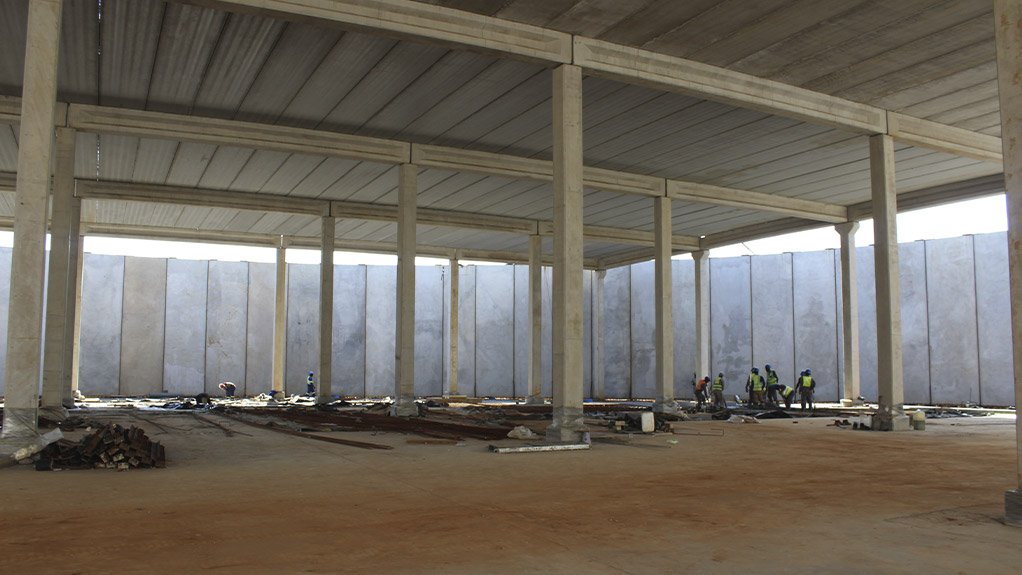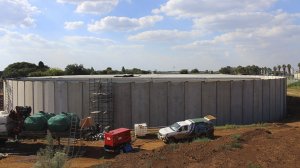South Africa refines construction of precast-concrete reservoirs



This modular approach saves time in constructing reservoirs and, in so doing, mitigating the potential risk of project delays and cost overruns
The use of precast-concrete technologies also provides additional quality assurance on these reservoir construction projects
This article has been supplied as a media statement and is not written by Creamer Media. It may be available only for a limited time on this website.
Precast concrete has helped to accelerate and mitigate risks on complex civil-engineering construction projects the world over. This includes on demanding reservoir projects that are traditionally built using cast-in-place concrete methods.
South Africa has gradually followed suit with many municipalities and their engineering teams now also specifying precast concrete reservoirs in the early phases of water-augmentation projects to overcome many of the challenges associated with constructing these structures using in-situ methods.
Located in large cities and rural areas, the more recent precast-concrete reservoir projects in the country range in sizes of between 10ML to 35ML. Together, these projects constitute about 350ML of water-storage capacity.
This modular approach saves time in constructing these structures and, in so doing, mitigating the potential risk of project delays and cost overruns. Using the precast concrete system, reservoirs can be constructed significantly faster than cast-in-place methods.
The use of precast-concrete technologies also provides additional quality assurance on these projects. This is considering the level of control that prefabrication offers, in terms of curing, temperature, mix design and formwork. These are among the key factors that regulate the quality of civil-engineering construction projects, including reservoirs, and which precast-concrete technologies sufficiently address.
This unique approach that is being deployed in the country is based on international best practice in precast-concrete reservoir construction. It was designed and developed in South Africa for unique African conditions.
The system comprises a precast-concrete roof, as well as a vertically pre-stressed and horizontally post-tensioned wall structure. However, the real innovation lies in the way it is constructed on site to ensure a water-tight structure.
Fast and efficient roof construction
A typical precast-concrete roof structure comprises hollow-core slabs (HCS) that are placed on precast-concrete beams that are, in turn, supported by prefabricated columns.
The precast-concrete columns are connected to the in-situ bases via cast-in components, or “column shoes”. These are secured to the hold-down bolts in the same manner as a conventional steel structure. Various column base configurations can be implemented to meet project specific requirements and their designs consider a minimum safe bearing capacity of 200kPa at founding level.
The precast-concrete beams are then installed onto the receiving columns. They are secured with dowels that protrude from the columns.
This is followed by the installation of HCS onto the beams and locked into place using a tie-steel reinforcing and in-situ concrete inside their hollow cores. The stirrups protruding from the precast beams serve as a mechanical interlock to form a composite mechanism with the infill concrete.
This is a tried-tested approach that has been used widely in South Africa to construct reservoir roofs on hybrid concrete construction projects where the wall is built using traditional methods.
Precast-concrete reservoir roof structures are up to five times faster to build than cast-in-place construction processes.
A reservoir roof is one of the final aspects of the works programme when it is constructed using cast-in-place methods. It is undertaken once the wall and in-situ columns reach their final height. Many tons of scaffolding must be installed inside the reservoir to support the forms for the frame of the roof structure. The extensive associated reinforcement and concrete works, including placement and stripping of the shutters, also requires close management. This is in addition to the timely coordination of the concrete trucks to site for the continuous concrete pours.
A total precast-concrete solution
There is also very little scope for error in the construction of an in-situ reservoir wall.
It entails significant steel-fixing and the installation of the side shutters is an onerous process. Care also needs to be applied when managing processes such as the placement of the concrete to avoid segregation and the displacement of the reinforcement to ensure a
watertight structure. Any mistakes in this aspect of the works programme will require rework and result in costly delays.
A precast-concrete wall system provides absolute control over the entire construction process and is significantly faster than cast-in-place methods.
Prefabricated reservoir walls consist of precast-concrete panels that have been designed to the required thickness. They have been prestressed during manufacturing and include cast-in-sleeves that have been strategically positioned according to the design requirements for post-tensioning on site.
The first panel is placed and supported temporarily and anchored by the following precast-concrete elements. This approach requires minimal propping and frees up space. The wall foundation, or “ring footing” is designed to transfer vertical loads from the wall and roof to the ground. It also translates the shear force in the wall due to water pressure, into the ring tension in the foundation. This tension is countered with adequate rebar cast into the “ring footing”.
Unbonded cables are then threaded through the sleeves and joints between the panels. They are temporarily sealed with rubber gaskets to enable the low viscosity grout to flow through all sleeves and joints. This grout is self-healing and achieves strengths of up to 100MPa in a short period. It is cooled to ensure flowability and pumped around the circumference of the reservoir in a controlled manner.
After the grout has cured to a strength of 80MPa, the cables are stressed to their specified yield via special buttress panels that have been equally spaced along the perimeter.
The wall is then pinned by casting a 200mm to 250mm high reinforced kicker on the wall footing on both sides of the wall panels.
Joints between the panels are grouted with a high-flow, high strength grout. This is followed by post-tensioning that renders the joint in compression to achieve water tightness. The wall has also been designed to a 1MPa minimum residual compressive stress.
Corestruc continues to demonstrate the efficacy of constructing reservoirs in this manner. In addition to ensuring timely and accurate project completion, there are many more benefits of this system. This includes decongesting construction sites and enhanced health and safety, which are incorporated during the manufacture of the precast-concrete reservoir system.
Comments
Press Office
Announcements
What's On
Subscribe to improve your user experience...
Option 1 (equivalent of R125 a month):
Receive a weekly copy of Creamer Media's Engineering News & Mining Weekly magazine
(print copy for those in South Africa and e-magazine for those outside of South Africa)
Receive daily email newsletters
Access to full search results
Access archive of magazine back copies
Access to Projects in Progress
Access to ONE Research Report of your choice in PDF format
Option 2 (equivalent of R375 a month):
All benefits from Option 1
PLUS
Access to Creamer Media's Research Channel Africa for ALL Research Reports, in PDF format, on various industrial and mining sectors
including Electricity; Water; Energy Transition; Hydrogen; Roads, Rail and Ports; Coal; Gold; Platinum; Battery Metals; etc.
Already a subscriber?
Forgotten your password?
Receive weekly copy of Creamer Media's Engineering News & Mining Weekly magazine (print copy for those in South Africa and e-magazine for those outside of South Africa)
➕
Recieve daily email newsletters
➕
Access to full search results
➕
Access archive of magazine back copies
➕
Access to Projects in Progress
➕
Access to ONE Research Report of your choice in PDF format
RESEARCH CHANNEL AFRICA
R4500 (equivalent of R375 a month)
SUBSCRIBEAll benefits from Option 1
➕
Access to Creamer Media's Research Channel Africa for ALL Research Reports on various industrial and mining sectors, in PDF format, including on:
Electricity
➕
Water
➕
Energy Transition
➕
Hydrogen
➕
Roads, Rail and Ports
➕
Coal
➕
Gold
➕
Platinum
➕
Battery Metals
➕
etc.
Receive all benefits from Option 1 or Option 2 delivered to numerous people at your company
➕
Multiple User names and Passwords for simultaneous log-ins
➕
Intranet integration access to all in your organisation




















